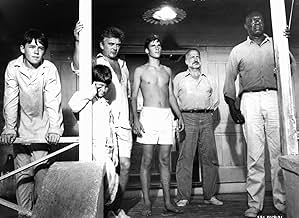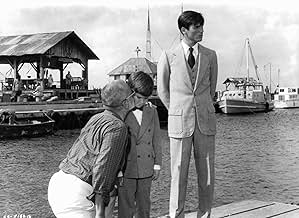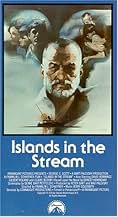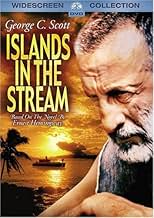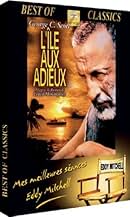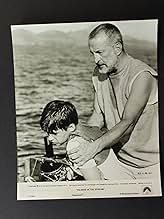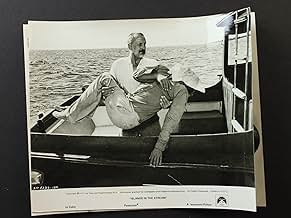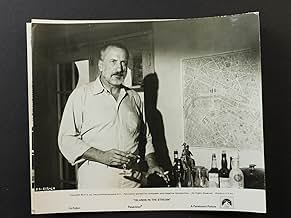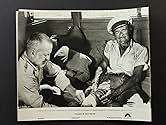VALUTAZIONE IMDb
6,5/10
1745
LA TUA VALUTAZIONE
Aggiungi una trama nella tua linguaAn isolated sculptor is visited by his three sons just before the start of WWII.An isolated sculptor is visited by his three sons just before the start of WWII.An isolated sculptor is visited by his three sons just before the start of WWII.
- Regia
- Sceneggiatura
- Star
- Candidato a 1 Oscar
- 4 candidature totali
Recensioni in evidenza
From the opening score and scenes of the water, I was drawn to watch this movie. It was filmed somewhere in the Caribbean and the location was breathtaking. George C. Scott was perfect in the role of Tom Hudson, an Ernest Hemingway-ish character who was a complicated, lonely artist and expatriate who sculpted, drank, and fished his life away. It wasn't until the tragic end that he came to know what he'd been missing.
The music score was haunting and beautiful. I was so impressed with it that I ordered the soundrack.
The music score was haunting and beautiful. I was so impressed with it that I ordered the soundrack.
This film had been slated by some English critics I later discovered - one describing it as "awful". I hadn't read about it beforehand and was pleasantly surprised - no violence, explosions, sex! A soft, gentle film with romantic and family angst heavily emphasised. George C Scott was excellent in the 'Hemingway' role and had splendid support from the rest of the cast, especially Claire Bloom and Julius Harris (I except David Hemmings from this who came close to spoiling it with hamming it up; very annoying). The ending didn't do the rest of it justice, I felt; a little too much sugar! Well photographed and a good score too. A good film for a wet afternoon.
This is one of the most memorable and moving films I saw in the 70s. Perfectly photographed and gently presented, this drama of a family dissecting how they feel about their artist father and his island atoll existence transports the viewer to genuinely feel as though we have been there as well. I revisited this film several times in 1978 taking friends and family and it became a completely immersing experience, and each visit made me admire the production, writing and themes more. It is presented as a trilogy, a family photo album in three parts, each with quiet profound realizations (without the screaming today would need) and presents the often sad or misplaced loyalty / admiration this 'great man' (Scott) commands but does not perhaps deserve. It is just a great great film instead. The scene in the second sequence where estranged wife Claire Bloom visits and takes him for a walk along the beach contains some of the most powerful acting I have ever enjoyed.. especially when Scott realizes why she has visited. Any time you see this film available, buy it or see it or take a good friend or family pal. Make it part of your life. I wish I could get a DVD and keep it so I can see it anytime. The music score is unforgettable. ISLANDS IN THE STREAM is one of the great 70s movies. Sad that it is so unknown. But you can change that. Spectacular young actor Hart Bochner possibly 19 at the time is the eldest of the three brothers, the younger two matching him as excellent actors. David Hemmings, just on the verge of losing his BLOW UP looks plays a drunken pal, and the glorious Claire Bloom as mentioned above is sublime. Add that to the Goldsmith score and the tropical locale, it is a solidly realized family drama that deserves wide appreciation.
George C. Scott is at his best in this adaptation of a Hemingway story (which, if I'm not mistaken was left unfinished) about a man who, late in life, is experiencing regrets over the loss of time with his sons. The main character, like Hemingway, was married multiple times and always seemed to run out on them shortly after the children were born. As a result, his relationships with his three sons is strained, to say the least. It's obvious Hemingway was being autobiographical here, but unlike the lead in the movie who tries to make good (albiet late), Hemingway chose suicide over mending fences. At least the lead character TRIES to make a run from his tropical island home to the mainland to be with his kids full-time. To me, these parallel stories (true and fictional) makes this movie incredibly sad and wistful, while at the same time great acting and exceptional writing provide great impact as well.
"Islands in the Stream" takes place on an island in the Caribbean just before World War II. George C. Scott plays a sculptor, Thomas Hudson, who married twice, has three sons, and chooses to work in isolated island exile. Claire Bloom plays his estranged wife. The film has an episodic structure, probably because the screenwriter, Denne Bart Petitclerc based his script on a series of short stories by Ernest Hemingway that appeared in a women's magazine under the title "Island (singular) in the Stream." Had Hemingway lived, he would have combined this and additional material to publish the collection as a novel. Petitclerc does a good job of translating the work to the screen.
The episodes could stand alone, yet each is sufficiently connected both in character and time consecutively to create a coherent, full-length film. The first, "The Boys," has the greatest strength. We see the arrival of Hudson's sons and how each brings out a different quality in the relation of parent and child. Scott handles this, and the whole film, with a natural, understated, and thoughtful strength. His admirers should make an effort to see this wonderful performance in this lesser-known production. In the middle episode, Claire Bloom as the second wife complements Scott beautifully in a dialog minuet which unfolds the decline of their marriage.
The film also features excellent performances by David Hemmings and Michael-James Wixted as the sensitive middle son. A check of the IMDb reveals that he never made another movie, and that's a loss.
While the action takes place on a British possession in the West Indies, the producers chose to do the actual filming in Hawaii. The score by Jerry Goldsmith and cinematography by Fred Koenekamp work well. Koenekamp received an Oscar nomination for his work here; he'd previously won it for his work on Patton, also with director Franklin Schaffner and Scott. I recommend seeing this film in widescreen format for Koenekamp's compositions.
The episodes could stand alone, yet each is sufficiently connected both in character and time consecutively to create a coherent, full-length film. The first, "The Boys," has the greatest strength. We see the arrival of Hudson's sons and how each brings out a different quality in the relation of parent and child. Scott handles this, and the whole film, with a natural, understated, and thoughtful strength. His admirers should make an effort to see this wonderful performance in this lesser-known production. In the middle episode, Claire Bloom as the second wife complements Scott beautifully in a dialog minuet which unfolds the decline of their marriage.
The film also features excellent performances by David Hemmings and Michael-James Wixted as the sensitive middle son. A check of the IMDb reveals that he never made another movie, and that's a loss.
While the action takes place on a British possession in the West Indies, the producers chose to do the actual filming in Hawaii. The score by Jerry Goldsmith and cinematography by Fred Koenekamp work well. Koenekamp received an Oscar nomination for his work here; he'd previously won it for his work on Patton, also with director Franklin Schaffner and Scott. I recommend seeing this film in widescreen format for Koenekamp's compositions.
Lo sapevi?
- QuizJerry Goldsmith often said this was his favorite score he composed.
- BlooperWhen the boat is slowly cruising up the river in Cuba looking for refugees, a crew member's hand can be seen moving tree branches away from the camera.
- Citazioni
Thomas Hudson: I know now there's no "one thing" that is true. It is all true.
- ConnessioniFeatured in Survival Scars: Franklin J. Schaffner as Auteur (2023)
I più visti
Accedi per valutare e creare un elenco di titoli salvati per ottenere consigli personalizzati
- How long is Islands in the Stream?Powered by Alexa
Dettagli
Botteghino
- Lordo Stati Uniti e Canada
- 5.596.173 USD
- Lordo in tutto il mondo
- 5.596.173 USD
Contribuisci a questa pagina
Suggerisci una modifica o aggiungi i contenuti mancanti


